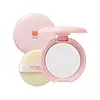What's inside
What's inside
 Key Ingredients
Key Ingredients

 Benefits
Benefits

 Concerns
Concerns

 Ingredients Side-by-side
Ingredients Side-by-side

Silica
AbrasiveCorn Starch Modified
AbsorbentDimethicone/Vinyl Dimethicone Crosspolymer
Skin ConditioningCaprylic/Capric Triglyceride
MaskingMica
Cosmetic ColorantMethicone
EmollientEthylhexylglycerin
Skin ConditioningGlyceryl Caprylate
EmollientDimethicone
EmollientMineral Salts
Skin ConditioningEthylene/Acrylic Acid Copolymer
Emulsion StabilisingCamellia Sinensis Leaf Extract
AntimicrobialMentha Arvensis Leaf Extract
Masking1,2-Hexanediol
Skin ConditioningParfum
MaskingSilica, Corn Starch Modified, Dimethicone/Vinyl Dimethicone Crosspolymer, Caprylic/Capric Triglyceride, Mica, Methicone, Ethylhexylglycerin, Glyceryl Caprylate, Dimethicone, Mineral Salts, Ethylene/Acrylic Acid Copolymer, Camellia Sinensis Leaf Extract, Mentha Arvensis Leaf Extract, 1,2-Hexanediol, Parfum
Dimethicone/Vinyl Dimethicone Crosspolymer
Skin ConditioningMagnesium/Potassium/Silicon/Fluoride/Hydroxide/Oxide
Zinc Stearate
Cosmetic ColorantPolymethylsilsesquioxane
Mica
Cosmetic ColorantDimethicone
EmollientMagnesium Myristate
Silica
AbrasivePhenyl Trimethicone
Skin ConditioningHydrogen Dimethicone
1,2-Hexanediol
Skin ConditioningCaprylyl Glycol
EmollientSodium Dehydroacetate
PreservativePrunus Persica Fruit Extract
AbrasiveCalamine
AbsorbentTocopheryl Acetate
AntioxidantParfum
MaskingButylene Glycol
HumectantArgania Spinosa Kernel Oil
EmollientSesamum Indicum Seed Oil
EmollientEnantia Chlorantha Bark Extract
Skin ConditioningBeta-Sitosterol
Emulsion StabilisingSerenoa Serrulata Fruit Extract
Skin ConditioningTocopherol
AntioxidantOleanolic Acid
Skin ConditioningBenzyl Salicylate
PerfumingLinalool
PerfumingHexyl Cinnamal
PerfumingLimonene
PerfumingDimethicone/Vinyl Dimethicone Crosspolymer, Magnesium/Potassium/Silicon/Fluoride/Hydroxide/Oxide, Zinc Stearate, Polymethylsilsesquioxane, Mica, Dimethicone, Magnesium Myristate, Silica, Phenyl Trimethicone, Hydrogen Dimethicone, 1,2-Hexanediol, Caprylyl Glycol, Sodium Dehydroacetate, Prunus Persica Fruit Extract, Calamine, Tocopheryl Acetate, Parfum, Butylene Glycol, Argania Spinosa Kernel Oil, Sesamum Indicum Seed Oil, Enantia Chlorantha Bark Extract, Beta-Sitosterol, Serenoa Serrulata Fruit Extract, Tocopherol, Oleanolic Acid, Benzyl Salicylate, Linalool, Hexyl Cinnamal, Limonene
 Reviews
Reviews

Ingredients Explained
These ingredients are found in both products.
Ingredients higher up in an ingredient list are typically present in a larger amount.
1,2-Hexanediol is a synthetic liquid and another multi-functional powerhouse.
It is a:
- Humectant, drawing moisture into the skin
- Emollient, helping to soften skin
- Solvent, dispersing and stabilizing formulas
- Preservative booster, enhancing the antimicrobial activity of other preservatives
Dimethicone is a type of synthetic silicone created from natural materials such as quartz.
What it does:
Dimethicone comes in different viscosities:
Depending on the viscosity, dimethicone has different properties.
Ingredients lists don't always show which type is used, so we recommend reaching out to the brand if you have questions about the viscosity.
This ingredient is unlikely to cause irritation because it does not get absorbed into skin. However, people with silicone allergies should be careful about using this ingredient.
Note: Dimethicone may contribute to pilling. This is because it is not oil or water soluble, so pilling may occur when layered with products. When mixed with heavy oils in a formula, the outcome is also quite greasy.
Learn more about DimethiconeThis ingredient is a silicone used to improve the texture of products and absorb oil. It does not get absorbed into the skin.
Like other silicones, Dimethicone/Vinyl Dimethicone Crosspolymer helps condition the skin by creating a barrier. In this sense, it can act as an emollient and trap moisture in.
This ingredient is a type of elastomer.
Learn more about Dimethicone/Vinyl Dimethicone CrosspolymerMica is a naturally occurring mineral used to add shimmer and color in cosmetics. It can also help improve the texture of a product or give it an opaque, white/silver color.
Serecite is the name for very fine but ragged grains of mica.
This ingredient is often coated with metal oxides like titanium dioxide. Trace amounts of heavy metals may be found in mica, but these metals are not harmful in our personal products.
Mica has been used since prehistoric times throughout the world. Ancient Egyptian, Indian, Greek, Roman, Aztec, and Chinese civilizations have used mica.
Learn more about MicaParfum is a catch-all term for an ingredient or more that is used to give a scent to products.
Also called "fragrance", this ingredient can be a blend of hundreds of chemicals or plant oils. This means every product with "fragrance" or "parfum" in the ingredients list is a different mixture.
For instance, Habanolide is a proprietary trade name for a specific aroma chemical. When used as a fragrance ingredient in cosmetics, most aroma chemicals fall under the broad labeling category of “FRAGRANCE” or “PARFUM” according to EU and US regulations.
The term 'parfum' or 'fragrance' is not regulated in many countries. In many cases, it is up to the brand to define this term.
For instance, many brands choose to label themselves as "fragrance-free" because they are not using synthetic fragrances. However, their products may still contain ingredients such as essential oils that are considered a fragrance by INCI standards.
One example is Calendula flower extract. Calendula is an essential oil that still imparts a scent or 'fragrance'.
Depending on the blend, the ingredients in the mixture can cause allergies and sensitivities on the skin. Some ingredients that are known EU allergens include linalool and citronellol.
Parfum can also be used to mask or cover an unpleasant scent.
The bottom line is: not all fragrances/parfum/ingredients are created equally. If you are worried about fragrances, we recommend taking a closer look at an ingredient. And of course, we always recommend speaking with a professional.
Learn more about ParfumSilica, also known as silicon dioxide, is a naturally occurring mineral. It is used as a fine, spherical, and porous powder in cosmetics.
Though it has exfoliant properties, the function of silica varies depending on the product.
The unique structure of silica enhances the spreadability and adds smoothness, making it a great texture enhancer.
It is also used as an active carrier, emulsifier, and mattifier due to its ability to absorb excess oil.
In some products, tiny microneedles called spicules are made from silica or hydrolyzed sponge. When you rub them in, they lightly polish away dead skin layers and enhance the penetration of active ingredients.
Learn more about Silica